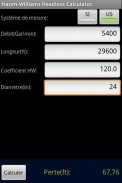




Water Headloss Calculator

Water Headloss Calculator介绍
The Hazen–Williams equation is an empirical formula which calculates pressure drop of water in circular pipes caused by friction. It is used in the design of water pipe systems such as fire sprinkler systems, water supply networks, and irrigation systems.
The Hazen–Williams equation has the advantage that the coefficient C is not a function of the Reynolds number, but it has the disadvantage that it is only valid for water.
Input parameters are flow, pipe diameter, lenght of pipe and C is a roughness coefficient, known as William Hazens coefficient, with values between 90 (more rough pipes) and 140 (smooth pipes, ex PVC).
You can select between imperial (U.S. customary units) and metric unit (International System of Units).
If you want to take into account the pressure loss in fittings and valves, and the selection coefficient C for each material, then find our version of the application pro at https://play.google.com/store/apps/details?id=com.transparentblue.headlossplus的哈森 - 威廉姆斯方程的是由摩擦引起的圆形管道水压降的经验公式计算。它是用在水管道系统,如消防喷淋系统,供水网络,灌溉系统的设计。
系数C雷诺数的函数,但它的缺点,这是仅适用于水的哈森 - 威廉姆斯方程的有优势。
输入的参数是流量,管径,管和C的长度的粗糙度系数,称为威廉Hazens系数,90(更粗的管道)和140(平滑管,聚氯乙烯除外)之间的值。
您可以选择英制(美国习俗单位)和公制单位(国际单位制)之间。
如果你要考虑到管件和阀门的压力损失,对每种材料的选择系数C,然后找到我们版本的应用程序亲https://play.google.com/store/apps/details?id = com.transparentblue.headlossplus


























